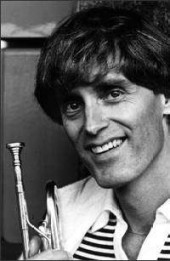Before his untimely death in 1978 at the young age of 44, Don Ellis was one of the most creative and innovative jazz musicians of all time. In a career span of less than 25 years, Don Ellis distinguished himself as a trumpeter, drummer, composer, arranger, recording artist, author, music critic, and music educator. However, Don Ellis is probably best remembered for his work as a big band leader. His orchestra, which was active from 1966-78, achieved enormous popular appeal at a time when the influence of big band music was noticeably fading.
Ellis's significance lies in his use of groundbreaking musical techniques and devices, new to the world of jazz. Ellis's innovations include the use of electronic instruments, electronic sound-altering devices, experiments with quartertones, and the infusion of 20th-century classical music devices into the jazz idiom. Ellis's greatest contributions, however, came in the area of rhythm.
New rhythmic devices ultimately became the Don Ellis trademark. His compositions frequently displayed time signatures with numerators of 5, 7, 9, 11, 19, 25, 33, etc. His approach within more conventional time signatures could be equally innovative through the use of rhythmic superimpositions. Ellis's rhythmic innovations despite much criticism were not gimmicks, but rather a direct result of his studies in non-Western musical cultures, which included graduate work at UCLA's Department of Ethnomusicology
Ellis ultimately applied his experiences and knowledge of the music of non-Western cultures to the rhythmic language of jazz. He was one of the first to have accomplished such a fusion of ideas, and his works as a composer and an author stand as a memorial reflecting a significant stage in the evolution of jazz.
A talented trumpeter with a vivid musical imagination and the willingness to try new things, Don Ellis led some of the most colorful big bands of the 1965-75 period. After graduating from Boston Unversity, Ellis played in the big bands of Ray McKinley, Charlie Barnet and Maynard Ferguson (he was featured with the latter on "Three More Foxes"), recorded with Charles Mingus and played with George Russell's sextet (at the same time as Eric Dolphy). Ellis led four quartet and trio sessions during 1960-62 for Candid, New Jazz and Pacific Jazz, mixing together bop, free jazz and his interest in modern classical music. However it was in 1965 when he put together his first orchestra that he really started to make an impression in jazz. Ellis's big bands were distinguished by their unusual instrumentation (which in its early days had up to three bassists and three drummers including Ellis himself), the leader's desire to investigate unusual time changes (including 7/8, 9/8 and even 15/16), its occasionally wacky humor (highlighted by an excess of false endings) and an openness towards using rock rhythms and (in later years) electronics. Ellis invented the four-valve trumpet and utilized a ring modulator and all types of wild electronic devices by the late '60s. By 1971 his band consisted of an eight-piece brass section (including French horn and tuba), a four-piece woodwind section, a string quartet and a two-drum rhythm section. A later unrecorded edition even added a vocal quartet.
Among Don Ellis's sidemen were Glenn Ferris, Tom Scott, John Klemmer, Sam Falzone, Frank Strozier, Dave MacKay and the brilliant pianist (straight from Bulgaria) Milcho Leviev. The orchestra's most memorable recordings were Autumn, Live at the Fillmore and Tears of Joy (all for Columbia). After suffering a mid-'70s heart attack, Ellis returned to live performing, playing the "superbone" and a later edition of his big band featured Art Pepper. Ellis's last recording was at the 1977 Montreux Jazz Fesival, a year before his heart finally gave out.
